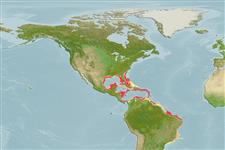Common names from other countries
Classification / Names / Names
Nomi Comuni | Sinonimi | Catalog of Fishes (gen., sp.) | ITIS | CoL | WoRMS
Environment: milieu / climate zone / depth range / distribution range
Ecologia
Associati a barriera corallina; distribuzione batimetrica 0 - 102 m (Ref. 847). Tropical; 33°N - 25°S, 98°W - 31°W (Ref. 847)
Western Atlantic: Throughout the Caribbean; south to Brazil.
Length at first maturity / Size / Peso / Age
Maturity: Lm ? range ? - ? cm
Colonies form flat, unifacial explanate plates with corallites in long, roughly concentric valley. Valleys are closely (2-4mm) spaced. Corallites are small, closed-together and faced forwards. Columellae are weakly developed. Grey, grey-brown or green in color.
Maximum depth from Ref. 83917. Zooxanthellate (Ref. 116012).
Life cycle and mating behavior
Maturità | Riproduzione | Deposizione | Uova | Fecundity | Larve
Members of the class Anthozoa are either gonochoric or hermaphroditic. Mature gametes are shed into the coelenteron and spawned through the mouth. Life cycle: The zygote develops into a planktonic planula larva. Metamorphosis begins with early morphogenesis of tentacles, septa and pharynx before larval settlement on the aboral end (Ref. 833).
Collin, R., M.C. Díaz, J. Norenburg, R.M. Rocha, J.A. Sánchez, M. Schulze, A. Schwartz and A. Valdés. 2005. (Ref. 415)
IUCN Red List Status (Ref. 130435)
CITES status (Ref. 108899)
Not Evaluated
Human uses
| FishSource |
Strumenti
Informazioni ulteriori
Age/SizeAccrescimentoLength-weightLength-lengthMorfologiaLarveAbbondanza
Fonti Internet
Estimates based on models
Preferred temperature
(Ref.
115969): 23.4 - 28, mean 26.5 (based on 392 cells).
Price category
Unknown.
